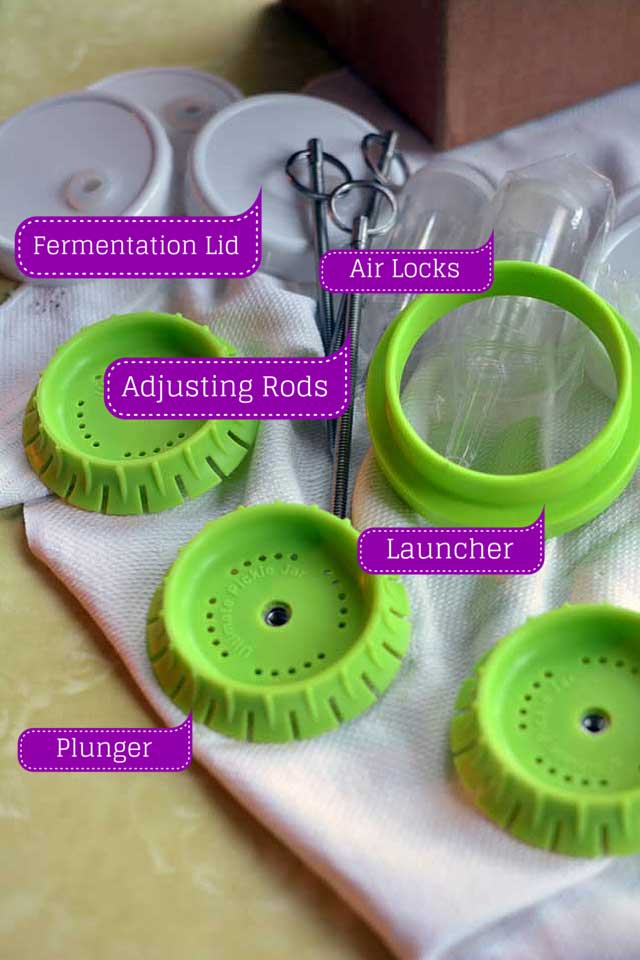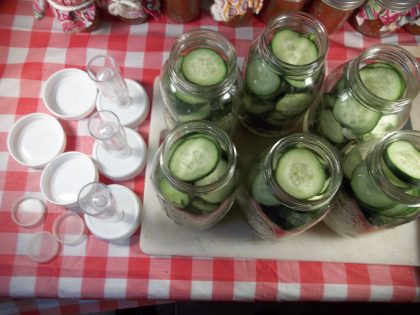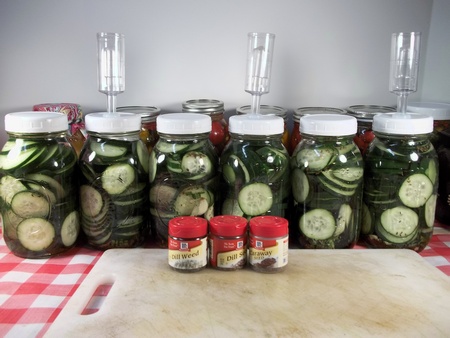What is lacto fermenting?
Lacto fermenting was first used by ancient man as a way to preserve foods as far back as 6000 B.C. Preserving foods is one reason mankind has survived in his path from hunter-gatherer to domestic farmer as he is today. Although it was mainly used to preserve at that time, I am sure they enjoyed the taste as well. As for the health benefits, the most noticeable one they found was the fact they had something to eat when nothing was found growing and ready to harvest. 🙂 It is hard to imagine life without a grocery store where spices and flavors from around the world are daily available in a small area.
It is the process of introducing a vegetable to an environment that favors the growth of beneficial Lacto Basilius bacteria and in return the bacteria create lactic acid which further discourages the growth of spoiling bacteria and thus preserves the food for later use.
Most forms of lacto fermenting use a liquid brine but some use a “bed system” like miso and the use of bran or sake lee beds. The latter require a more intense understanding of fermenting and should be attempted after a person acquires a little experience in the skill.
Lacto fermented foods also contain probiotics. These are the lacto bacteria that also live in our intestines and are vital to human health. Recently a surge in the consumption of these probiotic rich fermented foods like yogurt and kraut has sparked a lot of scientific research into their value to human life. Claims that these foods can cure cancer, aids and erectile dysfunction are common. 🙂 We do not take these claims to serious but do agree as most do that simple gut problems are lessened without argument and that a healthy GI tract makes for a healthier person.
A resent study showed a 2 ounce serving of saurkraut contained more live probiotics than a 100 count bottle of a popular probiotic supplement pill! Now that is a saving ! Google probiotic supplements!
Fermenting foods also saves you money, especially when you are raising a garden or using a small batch system that allows you to use the smallest amount of vegetables at a time. This reduces previously wasted foodstuff and provides tasty healthy treats as well. An example would be those miscellaneous vegetables aging ungracefully in the crisper drawer. Cut and toss them in a fermenting jar of brine and in a few days you will have a jar of pickled relish or tidbits to grace the table and provide a little added flavor as well as a smile because you did it yourself. Just for kicks and giggles…. price a bottle at a store near you today. $1.59 per quartt could be the rate you paid. Your DIY cost = $.01 salt and vegetables you may have discarded because they were not “pretty” And in the case of growing even the smallest of gardens, one can save a super large percentage of their fixed income food costs! I mean huge!
On that subject , it is claimed that the USA wastes about 40% of it’s grown harvest before it even reaches a market because it is not “pretty”. They are healthy food but not first class in the cosmetic sense. I am not referring to damaged vegetables and fruits but rather to ones like a short carrot or an oblong tomato . Anything that is not the stereotypical standard that we are accustomed to, is just not sent to market. And often times there is no other use for these vegetable other than animal use or complete waste. As a home gardener who regularly cuts away damaged portions of our produce this is not a problem at all.
What is the lacto fermenting process?
It is the process that converts vegetables into a state that is not acceptable to the growth of spoiling bacteria and microbes by favoring the growth of good lacto bacillis bacteria. Simply put…. we create a good environment for lacto bacteria to grow and they reward us by making a finished product that does not allow bad microbes to live in. Win win…… happy ….happy……happy 🙂
For vegetables, it basically involves adding a brine to a container of vegetables. This has a 2 fold purpose. It creates an salty environment that most bacteria do not like thus retards their growth yet favors the lacto bacteria which love the salt. It also helps limits the oxygen from reaching the vegetables which further inhibits the growth of spoiling microbes, yeast and mold as they favor O2. This favors the lacto bacteria which will then convert the sugars into lactic acid. As the ferment develops the sugars are diminished, the acidity is increased and the fermentation process slows. This acidity is also not favored by bad microbes! 🙂 What remains is a finished “pickled” product that is no longer a suitable place for harmful elements to grow and is effectively preserved. This product is now a flavorful foodstuff containing a diverse culture of probiotic goodness and will last much longer than the original vegetable.
In the case of dairy and meats the same occurs but not in a brine solution. Salami is fermented but since meat has little sugar, it must be added and the lacto bacteria play a minor role in this type of fermenting. With dairy there is a combination of yeasts and lacto bacteria that contribute to their formation. It is not a pure lacto ferment.
What foods can be fermented?
Most any vegetable that is grown can be successfully fermented. The flavor combinations are endless as are the finished product’s uses. From condiment to mainstay. Your imagination is the limit.
ilizes.
In the case of the kraut crock, there is a “moat” that the lid sits in that will allow excess CO2 to escape from once a certain amount of volume and pressure is reached. In the meantime the O2 content is diminished as the CO2 percentage is increased by the active ferment.
In the case of the FIdo type jar, the same enrichment and release process is preformed not by a moat but by the gasket. Once the required pressure and volume is reached, the gas will escape through a temporary opening between the gasket and the jar lid and mouth.
And in the case of the small batch mason jar containers, an airlock utilizing the “moat” theory is used. This micro moat system is usually a 3 piece system creating a liquid barrier to the outside elements and a release mechanism created by a floating bowl. There are also waterless valves currently being used that release at higher pressures and rely on pressure keeping contaminants from entering the ferment.
In conclusion, all 3 work well. Each has it’s own set of benefits and drawbacks. FOr example you do not want to use a 5 gallon crock system for a quart of veggies. Or you would not want to make a 4 gallon ferment with a new recipe only to find you did not like the result! 🙂
Continued========>
What do i need to get started?
You need a container to hold your brine. It should restrict contact with O2. It should be able to release the CO2 that is generated. That is all there is to a fermenting container. Goat bladders , skins and even banana-leaf lined holes in the ground have been used in the past but we will from this point on stay a little more modern.
Why is this important? The brine discourages bad bacteria, molds and yeasts that will spoil the fermenting vegetables . Salt has long been recognized as being a preservative and using a liquid form works effectively to discourage spoiling bacteria from the start of the process. At this point we have already helped our vegetables to survive nature’s onslaught. Lacto bacteria love salt. 🙂
While a ferment is underway, it will produce CO2 [ carbon dioxide ]. This hinders the growth of bad elements. This action when carried out in a controlled enclosure results in a CO2 enriched “blanket” which further discourages bad microbes from gaining a foothold in our ferment. Lacto bacteria love CO2 🙂
Traditionally used are:
- The sauerkraut crock
- The Fido jar
- The small batch mason jar systems such as our Pickle*Pushing No_Float Jar*Packer system
All these work well and operate basically the same. They hold brine and limit contact with the outside air which contain possible contaminating microbes seeking a place to colonize. These bad microbes and bacteria usually require O2 [ oxygen ] to thrive.
Type of vessel: Grandma's Kraut CrockDescription: Large usually earthern vessel with built in “moat” that functions as an effective airlock when filled with water and the lid placed in it.
Pro’s and Cons: The unit is heavy and is best suited for large batchs. It requires weights to hold contents under the brine. Due to size it will hold a more even temperature and as it is also made of opaque material sunlight can not effect the contents.
Almost every family had a few of these in their possession. IF you are using an heirloom, keep in mind that old vessels may have contained a lead based finish and may not be the best thing to use actively.
The crock is great for large batchs. But be prepared to process the resulting fermented foods unless your audience has some heavy eaters. The large batch is best suited for tried and proven recipes. There is nothing like having a 3 gallon or larger ferment finish and finding out that it had “just to dam much garlic!”.
Type of vessel: Fido type wire bail jarDescription: A type of glass jar once popular in the USA for home canning but widely replaced by the “mason jar” due to it’s failure to fully seal during the heat based processes used to can foods. It does not require an airlock to operate and works well for a fermenting container. CO2 escapes with a burping action involving the gasket when enough pressure develops
Pro’s and Cons: The jar is imported from Italy and very costly. There are functional “knock-offs” on market but the parts do not always interchange. They are costly to obtain.They call for a weight system to hold contents under brine. They are harder to maintain during the fermenting process as the lid does get in the way at times especially if used with a water filled airlock especially. There are many sizes available.
A good system all in all with cost being the biggest drawback. Some concern about the random release of CO2 from the gasket and causing spillage has been reported. Installing a good quality grommet and airlock helps but also makes accessing the jar top work it a lot harder. Using a water-less airlock solves both of these problems effectively.
Type of vessel: Mason jar
Description: A standardized make of jar used extensively in the home canning and fermenting field. These are adapted with a special lid and gasket and fitted with an external airlock to allow CO2 to escape.
Pro's and Cons: The jars are readily available and affordable. There are many sizes available. They are a good choice for small batch fermenting . They do require a weight system. System depends on good gasket and grommet to maintain airtight integrity.
A good system to use for small batch rotational fermenting. Plan your needs and only ferment what you need in a steady and specific time frame to avoid having to process for long term storage and deliver probiotic rich food to your table.
In conclusion, all 3 work well. Each has it’s own set of benefits and drawbacks. For example you do not want to use a 5 gallon crock system for a quart of veggies. Or you would not want to make a 4 gallon ferment with a new recipe only to find you did not like the result! 🙂
The “weight required” problem can be solved using our own product. The Pickle*Pushing No_Float Jar*Packer ,which effectively holds fermenting vegetables under the brine and are available to fit most quart and larger sizes of both the Fido and mason jar jar lines. Cleanup is a breeze and using our “low profile” water-less airlock also improves the enjoyment of using the fido jars as well as making use of storage space a lot more efficient.
So to recap: If you want volume….. use granny’s kraut crock.
If you want small steady batch of probiotics to eat fresh at your table…. Create a usage chart and ferment just what you need and serve before the shelf life starts to require the possibility of longer term processing to store.
ANd that is all folks! Enjoy and do not fret…………..
Here are some links to great FaceBook Groups that will help you almost instantly if you are polite! 🙂
Fermenters Kitchen : General fermenting group. Very active and friendly.
Fido Fermentation : A site for Fido enthusiasts
Kefir Time : A kefir sharing group
The Salt Cured Pickle: A spinoff group and great.
ANd many more. These are just a few we post to 🙂



